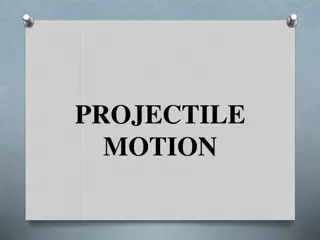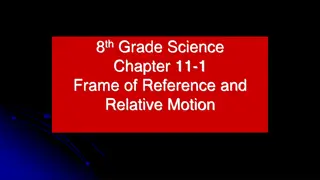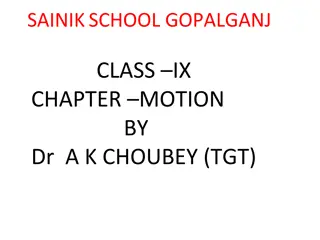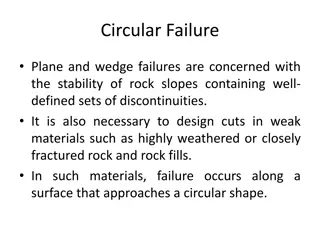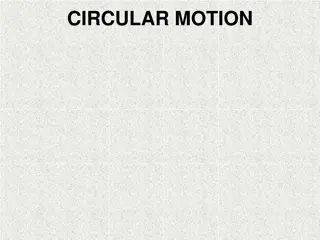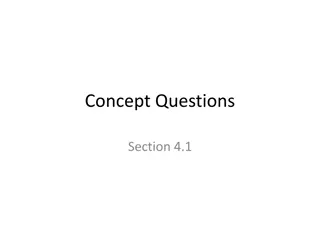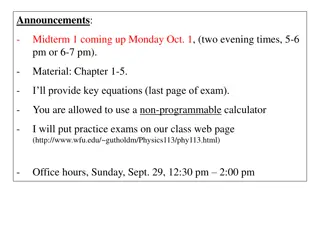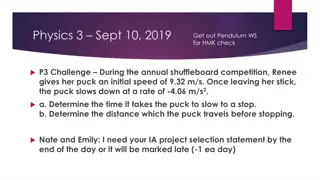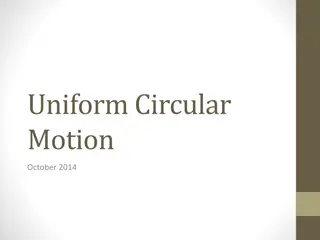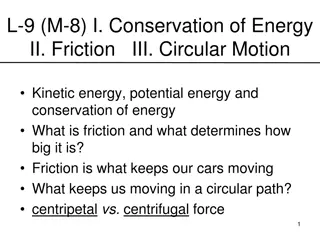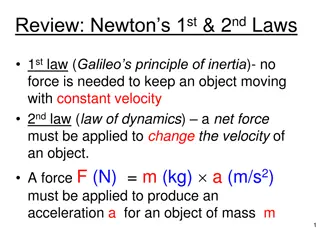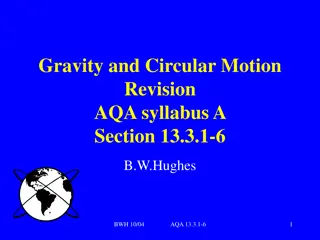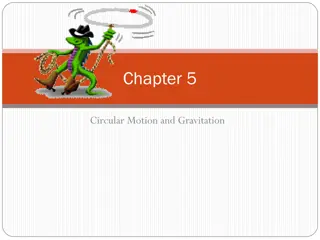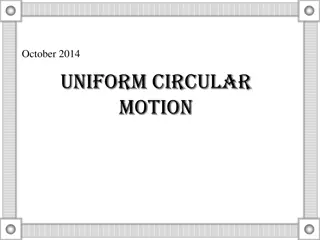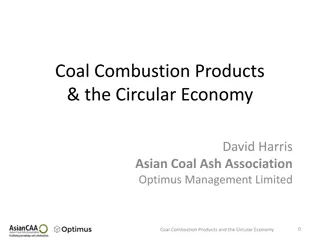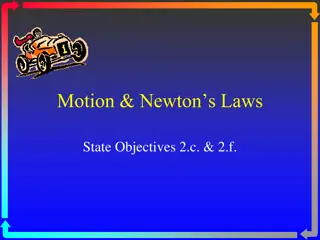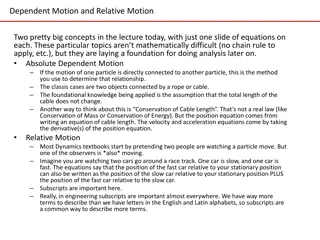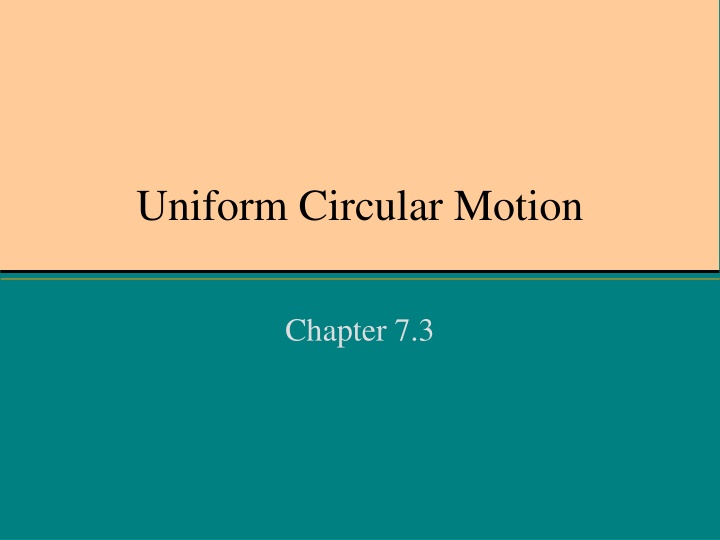
Understanding Uniform Circular Motion in Physics
Explore the concept of uniform circular motion, where objects move at a constant speed along a circular path. Learn how to determine speed, consider acceleration in circular motion, and understand centripetal acceleration. Examples and explanations provided.
Download Presentation

Please find below an Image/Link to download the presentation.
The content on the website is provided AS IS for your information and personal use only. It may not be sold, licensed, or shared on other websites without obtaining consent from the author. If you encounter any issues during the download, it is possible that the publisher has removed the file from their server.
You are allowed to download the files provided on this website for personal or commercial use, subject to the condition that they are used lawfully. All files are the property of their respective owners.
The content on the website is provided AS IS for your information and personal use only. It may not be sold, licensed, or shared on other websites without obtaining consent from the author.
E N D
Presentation Transcript
Uniform Circular Motion Chapter 7.3
Uniform Circular Motion Uniform circular motion is defined by any object that is moving at constant speed in a circular path. Determining Speed: The distance an object moving in a circular path is equal to the circumference (C = 2 r). The time it takes an object to complete one revolution is called the period (T). It then follows that the speed of an object moving in a circular path can be determined by: v = d/t = C/T = 2 r/T
Example #1: A 1500 kg racecar takes 1 minute to complete one lap of a circular racetrack with a radius of 400. meters. Determine the speed of the racecar. ? =? ?=? ?=2?? ? ? =2?(400.?) 60.? = 42?/?
Uniform Circular Motion If an object is moving at constant speed in a circular path, can it be accelerating? Yes Although the speed may be constant, the direction is changing. If direction is changing over time, then the velocity must be changing. Acceleration is the change in velocity over time (a = v/ t). And if the velocity is changing over time, then the object must be accelerating. v v v v
Circular Motion Instantaneous Velocity 1. The velocity vector is at right angles to the position vector 2. The velocity vector is tangent to the circle at any given point along the circle. v2 r2 r1 -r1 r r2 v1 ? = ? r1 ?
Circular Motion Centripetal Acceleration (ac) The acceleration of an object moving in a circular path always points towards the center of the circle, and is perpendicular to the velocity vector. v2 -v1 v2 v v v1 r ? ?? ?? = ?
Note that while the direction of the position and velocity vectors change, their magnitudes do not. Centripetal Acceleration The angle between r1 and r2 is the same as the angle between v1 and v2. Therefore, the triangles these vectors make are similar such that: ? ? = ? r2 ? If you divide both sides by t: -r1 r ? ? 1 ?= ? ? 1 ? Where : ?/ ? = ? and ?/ ? = ? Hence: -v1 ? ?=? v2 ? and v ??=?2 ?
Example #2: In example #1, you determined the speed of a race car traveling around a circular racetrack to be 42 m/s. Knowing that the radius of the racetrack is 400. meters, determine the centripetal acceleration of the racecar. ??=(42? ?)2 ??=?2 ??= 4.4? ?2 400? ?
Centripetal Acceleration An alternative representation for centripetal acceleration can be derived using the circumference and period of revolution. ? = 2?? ? =? ? Substituting into ac = v2/r ?=2?? 2 2?? ? ? ??= ??=4?2? ?2
Circular Motion Centripetal Force To make an object move in a circular path, an external force must act perpendicular or at right angles to its direction of motion. This force is called centripetal force. Instantaneous direction of velocity Direction of force required to make object move in a circular path (towards the center) ? ??
Centripetal Force Centripetal force is determined by: The mass of the object (m). The speed of the object around the circle (v). The radius of the circle (r). Using Newton s 2nd Law of Motion (Fc = mac), centripetal force is mathematically represented as follows: ??=??2 Fc ? Note: Centripetal force is an unbalanced net force
How the Factors Affect Centripetal Motion ??=??2 ? Which graph shows the proper relationship with respect to force: Force vs. Mass. Force Speed Force Force vs. Speed. Radius Force Force vs. Radius. Mass
Objects that travel in circular paths. What is the source of the force? The Earth Sun System: A racecar traveling around a turn on the racetrack: An athlete throwing the hammer: Gravity Friction Tension Fg ?? ??
Example #3: In example #2, you determined the centripetal acceleration of a race car traveling around a circular racetrack to be 4.4 m/s2. Determine the frictional force acting on the 1500-kg racecar that will allow it to negotiate the turn. ????= ?? ??= 6.6 103? ?? Since ????= ?? ???= ??2 ?=?? ??= (1500??)(4.4? ?2)
The path of objects. If the centripetal force were suddenly removed from an object moving in a circular path, what trajectory (or path) would it follow?
Which Path? Why? Because of Inertia An object in motion wants to remain in motion at constant speed in a straight line. If the unbalanced centripetal force is removed, the object will continue in a straight path. (a) (b) (c)
Example #4: A 1.5 kg cart moves in a circular path of 1.3 meter radius at a constant speed of 2.0 m/s. Determine the magnitude of the centripetal acceleration. Determine the magnitude of the centripetal force. Determine the period.
Example #4: (cont.) Centripetal Acceleration: ac = v2/r = (2.0 m/s)2/(1.3 m) = 3.1 m/s2 Centripetal Force: Fc = mac = (1.5 kg)(3.1 m/s2) = 4.6 N Period: T = C/v = 2 r/v = 2 (1.3 m)/(2.0 m/s) = 4.08 s
Motion & Forces What you already know: Velocity a measure of the change in distance over time with direction. Mass A measure of the amount of matter an object contains. Acceleration A measure of the change in velocity over change in time. A Net Force A push or pull that is equal to the mass of the object multiplied by its acceleration (F = ma).


